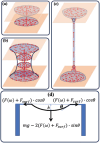Fluid Ferroelectric Filaments
- PMID: 38126584
- PMCID: PMC10916631
- DOI: 10.1002/advs.202305950
Fluid Ferroelectric Filaments
Abstract
Freestanding slender fluid filaments of room-temperature ferroelectric nematic liquid crystals are described. They are stabilized either by internal electric fields of bound charges formed due to polarization splay or by external voltage applied between suspending wires. The phenomenon is similar to those observed in dielectric fluids, such as deionized water, except that in ferroelectric nematic materials the voltages required are three orders of magnitudes smaller and the aspect ratio is much higher. The observed ferroelectric fluid threads are not only unique and novel but also offer measurements of basic physical quantities, such as the ferroelectric polarization and viscosity. Ferroelectric nematic fluid threads may have practical applications in nano-fluidic micron-size logic devices, switches, and relays.
Keywords: electrically stabilized threads; ferroelectric liquid; fluid filaments.
© 2023 The Authors. Advanced Science published by Wiley-VCH GmbH.
Conflict of interest statement
The authors declare no conflict of interest.
Figures





References
-
- Rayleigh L., Proc. Lond. Math. Soc. 1880, 11, 57.
-
- Rayleigh L., J. Sci. 1892, 34, 145.
-
- de Gennes P. G., Prost J., in The Physics of Liquid Crystals, Claredon Press, Oxford: 1993.
-
- Jakli A., Saupe A., in One‐ and Two‐ Dimensional Fluids: Properties of Smectic, Lamellar and Columnar Liquid Crystals, Taylor And Francis, Boca Raton: 2006.
-
- Cheong A.‐G., Rey A. D., Mather P. T., Phys. Rev. E 2001, 64, 41701.
Grants and funding
LinkOut - more resources
Full Text Sources
